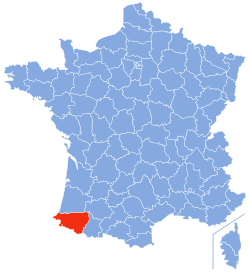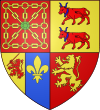Pyrénées-Atlantiques
| Pyrénées-Atlantiques | |||
|---|---|---|---|
| — Department — | |||
|
|||
 |
|||
| Coordinates: | |||
| Country | France | ||
| Region | Aquitaine | ||
| Prefecture | Pau | ||
| Subprefectures | Bayonne Oloron-Sainte-Marie |
||
| Government | |||
| - President of the General Council | Jean-Jacques Lasserre | ||
| Area1 | |||
| - Total | 7,645 km2 (2,951.8 sq mi) | ||
| Population (2007) | |||
| - Total | 643,090 | ||
| - Rank | 37th | ||
| - Density | 84.1/km2 (217.9/sq mi) | ||
| Time zone | CET (UTC+1) | ||
| - Summer (DST) | CEST (UTC+2) | ||
| Department number | 64 | ||
| Arrondissements | 3 | ||
| Cantons | 52 | ||
| Communes | 547 | ||
| ^1 French Land Register data, which exclude estuaries, and lakes, ponds, and glaciers larger than 1 km2 | |||
Pyrénées-Atlantiques (Gascon: Pirenèus-Atlantics; Basque: Pirinio-Atlantiarrak or Pirinio-Atlantikoak) is a department in the southwest of France which takes its name from the Pyrenees mountains and the Atlantic Ocean.
Contents |
History
Basses-Pyrénées is one of the original 83 departments of France created during the French Revolution, on March 4, 1790. It was created from parts of the former provinces of Guyenne, Béarn, and Gascony and included the three traditional provinces of the northern Basque Country: Labourd, Soule and Basse-Navarre. It also included two tiny exclaves of Bigorre which were located within Béarn.
The previous history of the region, under the Ancien Régime, can be found at those individual articles.
On October 10, 1969, Basses-Pyrénées was renamed Pyrénées-Atlantiques.
Geography
Pyrénées-Atlantiques is part of the Aquitaine region of Southwest France. It is bordered by the Landes, Hautes-Pyrénées , Gers departments and the Bay of Biscay (mar Cantabrico in spanish) .
Principal settlements include Pau, Biarritz, Bayonne, Anglet, Urrugne and Saint-Jean-de-Luz.
Lac Gentau is located here.
Economy
Pyrénées-Atlantiques, a border province, has cultivated a number of economic and cultural links with Spain.
Two urban concentrations exist in the east and west of the département: Pau, which has 145,000 inhabitants, and 344,000 workers in the local area; and Bayonne - Anglet - Biarritz which has 166,400 inhabitants and 235 000 workers in the local area
Culture
The parts of the department that were part of Guyenne and Béarn have a culture heavily influenced by the Basques.
Both the Gascon language and the Basque language are indigenous to the region here. Gascon is an Occitan language that is more closely related to Catalan than it is to French. Basque is a language isolate. However, French, the official language of the French Republic, is today the native language of the majority and is spoken by virtually all inhabitants.
See also
- Cantons of the Pyrénées-Atlantiques department
- Communes of the Pyrénées-Atlantiques department
- Arrondissements of the Pyrénées-Atlantiques department
External links
- (French) Prefecture website
- (French) General Council website
- (English) Pyrenees-Atlantiques at the Open Directory Project
- (English) Pyrenees-Atlantiques Monuments, Villages, Walks and Attractions
|
|||||
